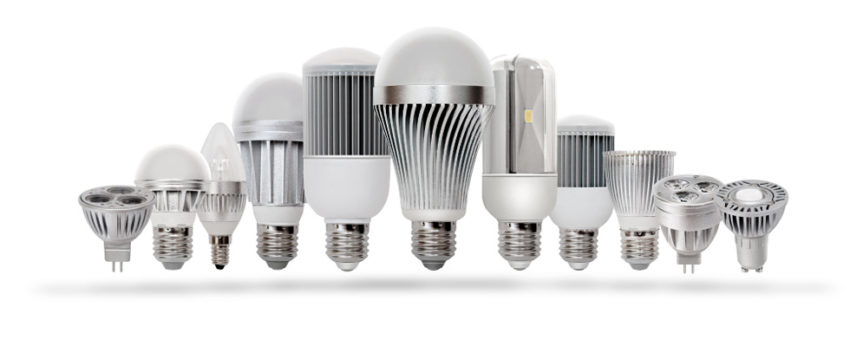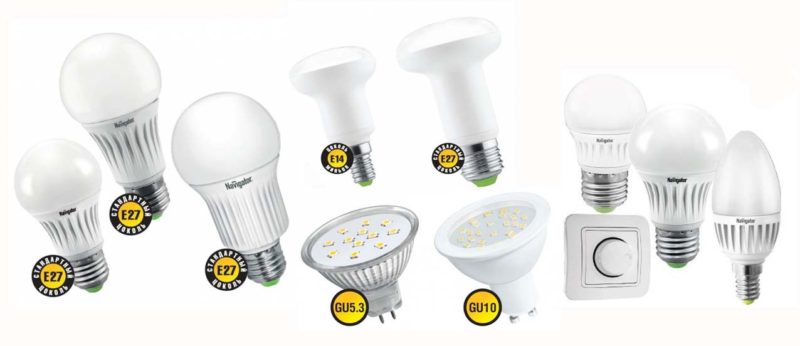Classification and types of LED bulbs
The wrong approach to the choice of LED lamps can permanently erase a positive attitude towards them. Having formed a false opinion, the user will not be able to appreciate the benefits of LED lamps in comparison with other lighting fixtures.
There are several varieties of LED lamps. When coming to the store, most customers pay attention only to the power, but this is not enough for the selection of a suitable and high-quality light bulb. It is worth considering the presence or absence of a heat sink, types of diodes, color temperature and angle of radiation.
Socket
LED lamps are divided by the type of socket into 3 classes:
- E - Edison base (threaded).
- G - pin base.
- T - pins of fluorescent lamps.
The most common is E. After the letter on the package are numbers that indicate the diameter. The numbers after the letter G indicate the number of contacts. Lamps of this type are purchased less often because they cannot be connected to the 220 volt network without connecting a power supply. Luminescent analogs also have numbers in the marking that indicate the distance between the contacts in parts of an inch. For example, T is 8/8 or T is 5/8 inch.
LEDs
The following types of LEDs can be found:
- LEDS. An innovative development in the LED lighting industry. Compared to counterparts, here the LED is attached directly to the base, which is necessary to increase heat transfer and reduce the size of the device. If the SMD and PSB bulbs are the same size, in the second case you can get a brighter light. Another advantage is the ability to choose a different geometric shape;
- Piranha chips. They were used in the first generations of light bulbs. The devices were not distinguished by high power, safety and energy efficiency;
- Filament diodes. This technology is still under development. But a number of significant advantages are already known: the angle of flux dispersion of 360 °, low prices and decent heat dissipation performance;
- powerful diodes. Buying a light bulb with these types of chips, it is worth remembering about a significant disadvantage: overheating. Therefore, you will need to install a large heat sink here;
- SMD .. Considered the most common. Diodes are installed on the surface of the matrix. Chips are small, do not heat much, are reliable and bright.
When Filament lamps appear on the market in sufficient quantities, they are expected to be in demand, because they emit light in the natural range of the spectrum, which is typical for incandescent bulbs. They will also be long-lasting and economical.
Color temperature
Exploring the types of LED bulbs should not forget that they differ in color temperature and shade. You should make a choice based on the purpose. Even the white color has several shades:
- 2700 K - reddish. Purchased to create an atmosphere of warmth and coziness in the room. Predominantly the color has medium and low wattage lamps;
- 3000 K - Warm white color with light yellowing. Suitable for living room, living room or children's room. The shade creates a feeling of relaxation and protection;
- 3500 K - neutral white color. Does not cause eye strain and does not distort color perception;
- 4000 K - cool white. The light will emphasize the cleanliness of the room, and give clear contours to the objects present in it. As a brain stimulant it is often installed in offices and offices;
- 5000-6000 К. Daylight white with high brightness values. Not used in homes and apartments, too harsh. Acquired for lighting small spaces, such as a greenhouse, a production shop, exhibition halls;
- 6500 K - a bluish shade of daylight color. Concentrates attention but can cause anxiety. Products with this temperature are installed in technical rooms and hospitals.
In addition to the listed, you can find colored modules on sale, which are used to create lighting systems and individual variants of home or apartment illumination.
Power
Power is not the main technical parameter when choosing a light bulb LED, but it is perceived as one of the most important, because it determines the power consumption, economy. If compared to ordinary incandescent bulbs, they consume much less energy.
We advise to watch thematic video:
On the body, as well as the packaging of LED devices there is a power marking. It ranges from 3 to 25 watts. Basically, the parameter is denoted by the letters "P" or "W". People who are used to using 100-watt incandescent bulbs can buy a 15-watt LED bulb, and it will illuminate the room the same way, but it consumes less energy.
Chips require less voltage, but they are able to emit more brightness. For example, a 10 watt LED product would be as bright as a classic 75 watt incandescent bulb. For the rest of the comparative characteristics, study the table below.
When buying an LED lamp, it is worth remembering that inexpensive Chinese products have less power and do not match the markings on the packaging. The difference between an expensive lamp and a cheap one can vary within 5 watts. It is recommended not to buy such lighting devices.
Angle of radiation
Incandescent bulbs emit light in all directions, because they have a transparent bulb. In most cases, this does not disturb anyone. But if you need to create directional lighting, such radiation will be characterized by large losses. LEDs emit light in a beam. This means that there will be no such losses, because the light is directed at specific objects.
In order for the product to illuminate more space, under the bulb chips are installed at different angles. If it is a night light or spotlight, you do not need a large angle of dispersion. For a room in an apartment or house, an angle of 180° is considered acceptable. If you need to fill a large space with light, you should choose a lamp with an angle of 270°.
Radiator
Radiator - this is an important element of the design of the LED lamp, which affects the service life. Different materials are used:
- Plastic. It is used only for LED-crystals with low power. Products are inexpensive.
- Aluminum. Characterized by high heat dissipation, but the contact can cause electric shock or burns.
- Composite. Provides safety and increases thermal conductivity.
- Ceramics. Provides electrical insulation, the devices have a high cost.
In a suspended ceiling, it is better to buy devices with ceramic or aluminum radiators. Only they will ensure sufficient heat dissipation in a confined space and reliability without adversely affecting technical performance.
The size and shape of the bulb
Buying a particular model, you should pay attention not only to the types of LED lamps, but also to the shape of the dome, for which they are purchased. If the bulb will stick out of the chandelier or go deep inside, it will reflect badly on the appearance.
It is worth considering that the size of the lamp does not always affect its power. The shape is also different, such as candle, pear, etc. Not so long ago, on sale appeared small bulbs with high power up to 15 watts.







